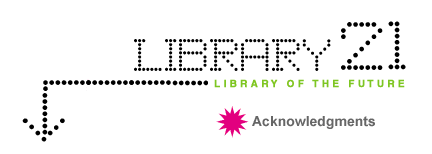
Concept,
research, graphic design & production
Victoria Beatty, vbeatty@u.washington.edu
Supervising professor
David M. Levy, dmlevy@u.washington.edu
About the Author
The author attended the 1962 World's Fair at an impressionable age and felt ever after a mysterious affinity for Seattle and the 21st century. She is a member of the second cohort of students in the University of Washington's Information School who will become 21st century librarians.
The text was adapted from a longer manuscript (in progress) as an exercise in writing and designing for the Web as a specialized mode of communication.
Acknowledgments
Heartfelt thanks are due to Dr. Robert M. Hayes, pioneering information scientist, emeritus Dean of the UCLA School of Library and Information Science, and inspiring teacher. His gracious consent to be interviewed for the project grew into generous mentorship as he offered research leads, insightful commentary, and a careful reading of two versions of this project. This is a work in progress, however, and any errors or omissions must be attributed solely to the author.
Thanks are also due to Christopher Prom of the American Library Association
archives and to the late Bob Chapel of the University Archives at the
University of Illinois. Their friendly research assistance made tracking
this story a happy adventure. Thanks also to Gary Lundell and Carla Rickerson
of the University of Washington Manuscripts and Special Collections, and
to Cameron Johnson of the Everett Public Library, who shared his research
on the Century 21 Exposition.
Garlands and bouquets are due to composer and friend Hugh Chandler, who wrote the soundtrack for the Flash movie, and to his daughter, Claire, who graciously contributed the voice-over. My gratitude also to David Levy, who offered not only a good assignment with scope for initiative and creativity, but also collegial good will and mentorship. And lastly, my deepest appreciation to Stuart Heady, my partner, who has fed and comforted me and listened to all my discoveries when I was too caught up in the project to remember about eating, and who has been a bottomless font of good ideas.
Colophon
This site was created using an iMac and iBook, Macromedia Dreamweaver MX, and Adobe Photoshop 5.5. Photographs were scanned on a Canon CanoScan N67OU color scanner. The primary typeface was Arial, with titles in 8Pin Matrix, created by Michel Bujardet. 8 Pin Matrix resembles the output of an antique FX-80 dotmatrix printer. ALA used a similar style for their logo in the 1962 exhibit, as did Xerox for a Library 21 brochure.
ITC Zapf ornamental dingbats were used to mimic the radiating light globes in the Library 21 exhibit, and also in homage to Charles and Ray Eames, whose chairs and other furniture were used throughout the exhibit. Times New Roman was used for the circular chapter headings, which were inspired by the exhibit's signs.